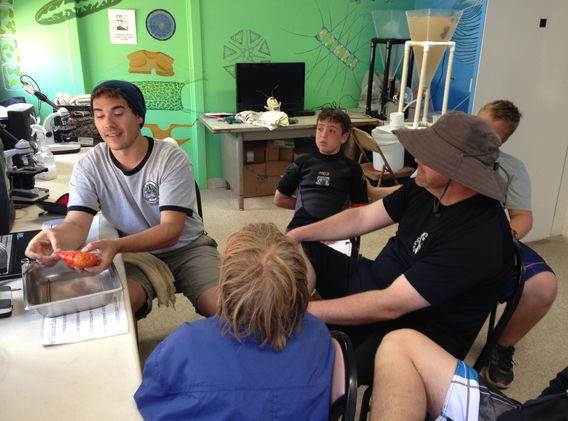

PMSC
Summer Education
Scout Camp BSA
Oceanography Merit Badge
The Oceanography Merit Badge is the primary class taught at the PMSC with over 500 scouts in attendance every summer. It is taught three sessions a day in the Ocean classroom where we use whiteboards, games, videos, experiments and outdoor activities to illustrate and educate scouts about the oceans. Requirement 8 has scouts write a 500 word essay or give a five minute speech on a topic in oceanography or their visit to an oceanographic institute. We have a good selection of books in the office of the marine science center that we encourage scouts to use to gain information on their favorite topics in oceanography in order to complete requirement 8.

Requirements
-
Name four branches of oceanography. Describe at least five reasons why it is important for people to learn about the oceans.
-
Define salinity, temperature, and density, and describe how these important properties of seawater are measured by the physical oceanographer. Discuss the circulation and currents of the ocean. Describe the effects of the oceans on weather and climate.
-
Describe the characteristics of ocean waves. Point out the differences among the storm surge, tsunami, tidal wave, and tidal bore. Explain the difference between sea, swell, and surf. Explain how breakers are formed.
-
Draw a cross-section of underwater topography. Show what is meant by:
-
Continental shelf
-
Continental slope
-
Abyssal plain
-
Name and put on your drawing the following: seamount, guyot, rift valley, canyon, trench, and oceanic ridge. Compare the depths in the oceans with the heights of mountains on land.
-
-
List the main salts, gases, and nutrients in seawater. Describe some important properties of water. Tell how the animals and plants of the ocean affect the chemical composition of seawater. Explain how differences in evaporation and precipitation affect the salt content of the oceans.
-
Describe some of the biologically important properties of seawater. Define benthos, nekton, and plankton. Name some of the plants and animals that make up each of these groups. Describe the place and importance of phytoplankton in the oceanic food chain.
-
Do ONE of the following:
-
Make a plankton net. Tow the net by a dock, wade with it, hold it in a current, or tow it from a rowboat.* Do this for about 20 minutes. Save the sample. Examine it under a microscope or high-power glass. Identify the three most common types of plankton in the sample.
-
Make a series of models (clay or plaster and wood) of a volcanic island. Show the growth of an atoll from a fringing reef through a barrier reef. Describe the Darwinian theory of coral reef formation.
-
Measure the water temperature at the surface, midwater, and bottom of a body of water four times daily for five consecutive days. You may measure depth with a rock tied to a line. Make a Secchi disk to measure turbidity (how much suspended sedimentation is in the water). Measure the air temperature. Note the cloud cover and roughness of the water. Show your findings (air and water temperature, turbidity) on a graph. Tell how the water temperature changes with air temperature.
-
Make a model showing the inshore sediment movement by littoral currents, tidal movement, and wave action. Include such formations as high and low waterlines, low tide terrace, berm, and coastal cliffs. Show how the offshore bars are built up and torn down.
-
Make a wave generator. Show reflection and refraction of waves. Show how groins, jetties, and breakwaters affect these patterns.
-
Track and monitor satellite images available on the Internet for a specific location for three weeks. Describe what you have learned to your counselor.
-
-
Do ONE of the following:
-
Write a 500-word report or
-
Give a five minute prepared speech
-
Topic options must be approved by your counselor and include:
-
Your favorite topic in oceanography
-
Your favorite marine animal
-
Your visit to an oceanographic institute, marine laboratory, or marine aquarium and what you learned wile there
-
-
-
Describe four methods that marine scientists use to investigate the ocean, underlying geology, and organisms living in the water.
BSA Aquarist
This award teaches scouts small and large scale aquarium management. Scouts will learn to set up, collect animals for, clean and monitor their own tank’s system as well as learn how the system in the center operates. Scouts will receive an education about what it takes to be a successful aquarist. Only offered at Emerald Bay!


BSA Oceanographer
Be ready to get wet! Taught almost entirely outside both in and on the water. To earn this award scouts will learn research survey techniques through hands-on training and will dive deeper into the concepts of fish physiology, kelp forest ecology, intertidal zonation, and plankton. This program is only offered at Emerald Bay. Completion of the Oceanography merit badge is required to participate. These may not be met concurrently. This program is also open to adults.












